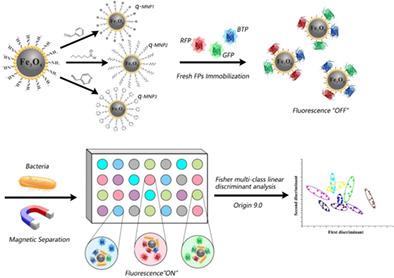当前位置:
X-MOL 学术
›
J. Mol. Recognit.
›
论文详情
Our official English website, www.x-mol.net, welcomes your feedback! (Note: you will need to create a separate account there.)
Gold nanoparticles-mediated fluorescent chemical nose sensor for pathogenic diagnosis and phenotype
Journal of Molecular Recognition ( IF 2.7 ) Pub Date : 2021-06-17 , DOI: 10.1002/jmr.2919 Yuanyuan Shen 1 , Feifei Lei 2 , Tian Meng 1 , Chaoyang Li 1 , Zhiqing Yang 1 , Jiaomei Huang 1 , Fengge Song 1 , Yi Wan 1
Journal of Molecular Recognition ( IF 2.7 ) Pub Date : 2021-06-17 , DOI: 10.1002/jmr.2919 Yuanyuan Shen 1 , Feifei Lei 2 , Tian Meng 1 , Chaoyang Li 1 , Zhiqing Yang 1 , Jiaomei Huang 1 , Fengge Song 1 , Yi Wan 1
Affiliation

|
Pathogens are one of the important factors affecting national economic construction. An ideal detection system for pathogen control with excellent sensitivity, high specificity, and time-saving is needed. Here, we reported a method for bacterial detection using gold nanoparticles-mediated fluorescent “chemical nose” sensors (GFCEs). The technique consists of gold nanoparticles-coated magnetic particle using benzaldehyde, octyl aldehyde, and pyrimidine-4-formaldehyde modified, respectively. And these positively charged nanocompound interacting with three different fluorescent proteins (FPs) to form three kinds of GFCEs, respectively, named GFCE1, GFCE2, and GFCE3. Upon binding with pathogenic cells, functionalized gold nanoparticles could identify patches on hydrophobic/functional surfaces of microorganisms, and self-assemble with living bacteria by complementary electrostatic interactions. The binding ability between GFCEs and bacteria determines the change of fluorescence response of three FPs from GFCEs. These feature fluorescent level are pathogen-specific, highly repeatable, and can be analyzed by Linear Discriminant Analysis (LDA). The combination of GFCE1 and GFCE2 has the best performance when detecting pathogens with concentrations of 106 cfu mL−1. The first discriminant within 15 minutes is 93.8%, which could be used for subsequent identification of unknown samples. The commonly applicable system provides a simple way for the rapid bacterial detection without preprocessing procedures.
中文翻译:

用于病原体诊断和表型的金纳米粒子介导的荧光化学鼻传感器
病原体是影响国民经济建设的重要因素之一。需要一种具有出色灵敏度、高特异性和省时的病原体控制的理想检测系统。在这里,我们报道了一种使用金纳米粒子介导的荧光“化学鼻”传感器 (GFCE) 进行细菌检测的方法。该技术由分别使用苯甲醛、辛醛和嘧啶-4-甲醛改性的金纳米粒子涂层磁性粒子组成。而这些带正电的纳米化合物与三种不同的荧光蛋白(FPs)相互作用形成三种GFCE,分别命名为GFCE1、GFCE2和GFCE3。与病原细胞结合后,功能化的金纳米粒子可以识别微生物疏水/功能表面上的斑块,并通过互补的静电相互作用与活细菌自组装。GFCEs 与细菌之间的结合能力决定了 GFCEs 中三种 FPs 荧光响应的变化。这些特征荧光水平是病原体特异性的、高度可重复的,并且可以通过线性判别分析 (LDA) 进行分析。GFCE1 和 GFCE2 的组合在检测浓度为 10 的病原体时性能最佳6 cfu mL -1。15分钟内的第一判别率为93.8%,可用于后续未知样品的鉴定。普遍适用的系统为快速细菌检测提供了一种简单的方法,无需预处理程序。
更新日期:2021-06-17
中文翻译:

用于病原体诊断和表型的金纳米粒子介导的荧光化学鼻传感器
病原体是影响国民经济建设的重要因素之一。需要一种具有出色灵敏度、高特异性和省时的病原体控制的理想检测系统。在这里,我们报道了一种使用金纳米粒子介导的荧光“化学鼻”传感器 (GFCE) 进行细菌检测的方法。该技术由分别使用苯甲醛、辛醛和嘧啶-4-甲醛改性的金纳米粒子涂层磁性粒子组成。而这些带正电的纳米化合物与三种不同的荧光蛋白(FPs)相互作用形成三种GFCE,分别命名为GFCE1、GFCE2和GFCE3。与病原细胞结合后,功能化的金纳米粒子可以识别微生物疏水/功能表面上的斑块,并通过互补的静电相互作用与活细菌自组装。GFCEs 与细菌之间的结合能力决定了 GFCEs 中三种 FPs 荧光响应的变化。这些特征荧光水平是病原体特异性的、高度可重复的,并且可以通过线性判别分析 (LDA) 进行分析。GFCE1 和 GFCE2 的组合在检测浓度为 10 的病原体时性能最佳6 cfu mL -1。15分钟内的第一判别率为93.8%,可用于后续未知样品的鉴定。普遍适用的系统为快速细菌检测提供了一种简单的方法,无需预处理程序。

























 京公网安备 11010802027423号
京公网安备 11010802027423号